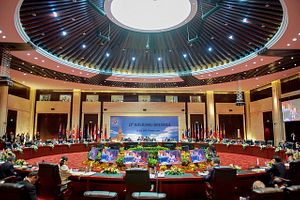The recent decision handed down by the Permanent Court of Arbitration (PCA) on the South China Sea, among other developments, have brought new focus on ASEAN, China and U.S.-Japan relations. For instance, the Japanese media devoted extensive space to covering the ASEAN Foreign Ministers’ Meeting held in July 2016. Among the stories, one headline proclaiming that Chinese diplomacy had triumphed over Japan and the United States stands out. In short, the piece argues that China has succeeded in splitting the ASEAN bloc. With Cambodia coming out in strong support of China, issues like the PCA ruling were not incorporated into any statements or agreements. Demands from Tokyo and Washington that the PCA decision be accepted were not passed, and instead the position of Cambodia, acting as China’s spokesperson to call for bilateral negotiations, was accepted.
In these sorts of analyses, ASEAN nations are never the protagonists. Rather, China, Japan and the United States are treated as the main actors in an accounting of what they have in store for ASEAN nations, which are always framed as if they lack agency. This is misguided thinking. Individual ASEAN nations have independent choices to make, and whether or not the ASEAN Foreign Minsters’ Meeting incorporates a joint statement on the PCA’s South China Sea decision, this is not about a nation being coerced by China, Japan or the United States; it is a policy chosen by ASEAN nations.
So why are we seeing press coverage that seemingly ignores the independence of ASEAN nations? One factor is that the Japanese media and others have painted the picture of a pure power-based struggle of Japan-United States versus China, or presented the South China Sea issue and the circumstances surrounding ASEAN from a realist perspective. ASEAN was never a security alliance, nor a mechanism by which to resolve issues such as territorial disputes. Premised on non-interference in internal affairs, the principle of unanimity, and the inevitable holding of regular meetings, ASEAN represents the culmination of numerous cooperative frameworks. Moreover, establishing deeper ties with countries outside the ASEAN region has led to expansions such as ASEM, ASEAN+3 and the East Asia Summit. These are prime examples of East Asian regional cooperation based on ASEAN centricity.
However, that sort of liberal regional cooperation is now coming up against realism, or power-based expansionism and the associated territorial disputes. Normally, the liberal argument would be that advancing regional cooperation would have a restraining effect on territorial and security-related conflicts and disputes. The path ASEAN has taken has basically followed this liberal line. Similarly, the principles of unanimity and non-interference in internal affairs could be described as safety mechanisms preventing the realism-based logic of each nation from finding its way inside ASEAN. But Southeast Asia has become the focal point of a power struggle between the United States and China, and when China has made forays into the South China Sea based on its own brand of realism, ASEAN has found it extremely difficult to cope as an organization.
Moreover, while individual Southeast Asian nations may still be able to cope with China or the United States openly employing the logic of territorial expansion, on the surface these arguments have concerned rules-oriented concepts such as the “rule of law” or “freedom of navigation.” This has made it difficult for the ASEAN to respond more effectively. In other words, while ASEAN appears to be a forum for discussion, its structure precludes it from actually producing a conclusion. That is why moving forward – and not just at the Foreign Ministers’ Meeting but at a wide range of meetings – we will continue to see differing perceptions of how ASEAN is dealing with this Chinese realism internally.
This is also evident in moves to identify fault lines in ASEAN’s internal structure. This continued focus on a cross-section of differences is perhaps inevitable in its own way. But even if there is an ongoing focus on rifts within ASEAN, they will be in the context of limited issues; as a whole there will be an even stronger need for ASEAN to function as it has in the past, which is to reach consensus. This also underscores the need to strengthen partnerships with extra-regional countries that support ASEAN.

































